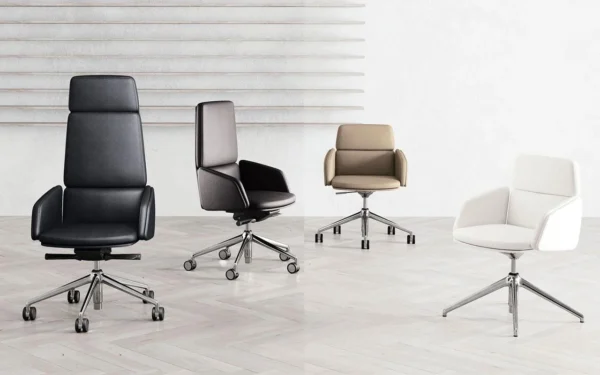
In today’s fast-paced work environment, the right office furniture can significantly influence our health and productivity. Among the many pieces of office furniture, executive chairs stand out as essential components designed to provide comfort and support for those who spend long hours at their desks. With the increasing recognition of the importance of ergonomic design, it’s crucial to understand how executive chairs contribute to back health, reduce fatigue, and improve posture.
The Importance of Ergonomics in Executive Chairs
Ergonomics focuses on designing products that accommodate the human body’s natural movements and postures. When it comes to executive chairs, this means creating a seat that supports proper alignment of the spine while allowing freedom of movement. High-quality executive chairs typically feature adjustable components, including seat height, backrest angle, and armrests. These adjustments enable users to customize their seating experience to their unique body type and working style.
An ergonomic executive chair supports the natural curve of the spine, particularly in the lumbar region, helping to alleviate discomfort that can arise from poor seating posture. Without adequate support, employees may find themselves leaning forward or slumping, which can lead to chronic pain and fatigue over time.
Reducing Fatigue Through Proper Support
Fatigue is a common complaint among professionals who sit for extended periods. Poorly designed chairs can exacerbate this issue by failing to provide the necessary support, leading to muscle strain and discomfort. Executive chairs, with their ergonomic features, help mitigate these problems.
By providing lumbar support, executive chairs reduce the strain on the lower back. This feature encourages a more upright posture, allowing the muscles in the back to relax and reducing fatigue. Moreover, well-designed executive chairs often include cushioning that evenly distributes weight, preventing pressure points that can cause discomfort during long work sessions.
Additionally, executive chairs that promote active sitting can help maintain energy levels. Some chairs encourage movement by allowing for slight rocking or tilting, which helps stimulate circulation and keep the muscles engaged. This subtle movement can lead to reduced feelings of fatigue and increased productivity.
Improving Posture with Adjustable Features
One of the key benefits of executive chairs is their adjustability. Many models offer a range of settings to suit individual preferences, including:
- Seat Height: A chair should allow the user to sit with their feet flat on the ground and their knees at a 90-degree angle. If the chair is too high or too low, it can lead to strain on the legs and back.
- Backrest Angle: The backrest should support the natural curve of the spine. Users should be able to recline slightly to relieve pressure on the lower back, but not to the extent that they lose lumbar support.
- Armrests: Adjustable armrests can prevent shoulder and neck strain by allowing the arms to rest comfortably. Proper armrest height should keep the shoulders relaxed and elbows close to the body.
By enabling users to adjust these features, executive chairs help promote good posture, which is essential for overall back health. Correct posture reduces the likelihood of developing musculoskeletal disorders and can lead to better concentration and focus during work hours.
The Long-Term Benefits of Executive Chairs
Investing in an ergonomic executive chair pays off in multiple ways. Employees who are comfortable and well-supported are likely to experience higher job satisfaction and productivity. Furthermore, reducing the risk of chronic back issues can lead to fewer sick days and lower healthcare costs for employers.
Studies have shown that comfortable seating can enhance cognitive function, leading to better decision-making and creativity. When workers are not preoccupied with discomfort, they can focus more on their tasks and contribute more effectively to their teams.
Moreover, a comfortable workspace reflects an organization’s commitment to employee well-being. This can boost morale and foster a positive workplace culture, making it an essential consideration for business leaders when selecting office furniture.
Additional Features to Consider
When selecting an executive chair, several additional features can further enhance comfort and health:
- Breathable Materials: Chairs made from breathable fabrics promote air circulation, reducing heat buildup and keeping users cool during long hours of sitting.
- Adjustable Lumbar Support: Some chairs offer adjustable lumbar support, allowing users to position the support exactly where it is needed most.
- Mobility: A chair with smooth-rolling casters allows for easy movement across the office, which can encourage standing up and stretching, further promoting health.
- Swivel Base: A swivel base enables users to reach different areas of their workspace without straining, promoting better posture and ease of access.
Tips for Using Executive Chairs Effectively
While having a quality executive chair is essential, it’s equally important to use it correctly. Here are some tips for maximizing the benefits of your chair:
- Take Regular Breaks: Standing up and moving around every 30 minutes can help alleviate pressure on the spine and reduce the risk of discomfort.
- Maintain an Ergonomic Desk Setup: Ensure that your desk is at the correct height and that your computer screen is at eye level. This alignment can help prevent neck strain.
- Practice Good Sitting Habits: Sit all the way back in the chair, using the backrest for support. Keep your feet flat on the floor and avoid crossing your legs.
Incorporating these practices alongside a well-designed executive chair can significantly enhance back health, reduce fatigue, and improve overall posture.
Choosing the right executive chair is not just a matter of comfort; it’s an investment in health and productivity. By prioritizing ergonomic design and making use of adjustable features, employers and employees alike can create a workspace that supports back health and promotes well-being. As we continue to recognize the importance of health in the workplace, the role of quality office furniture will only become more critical in shaping a productive, comfortable work environment.